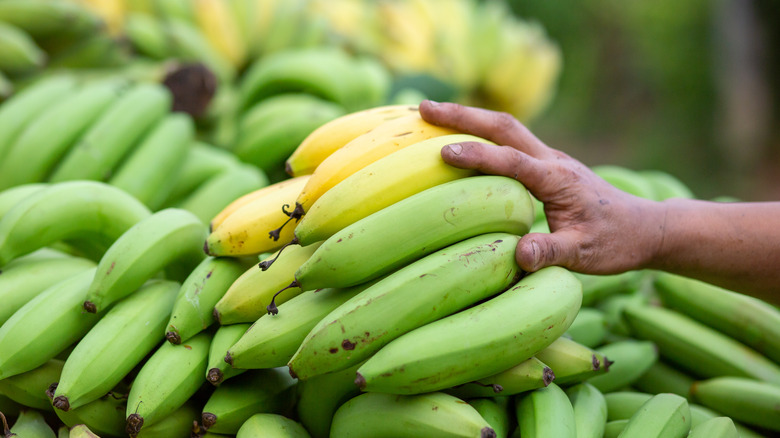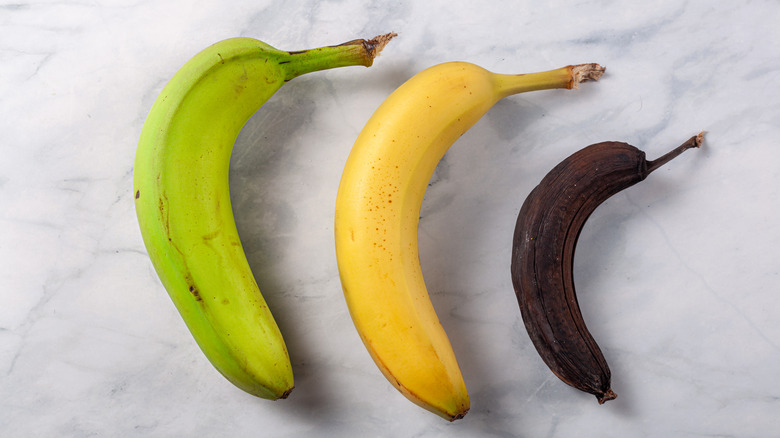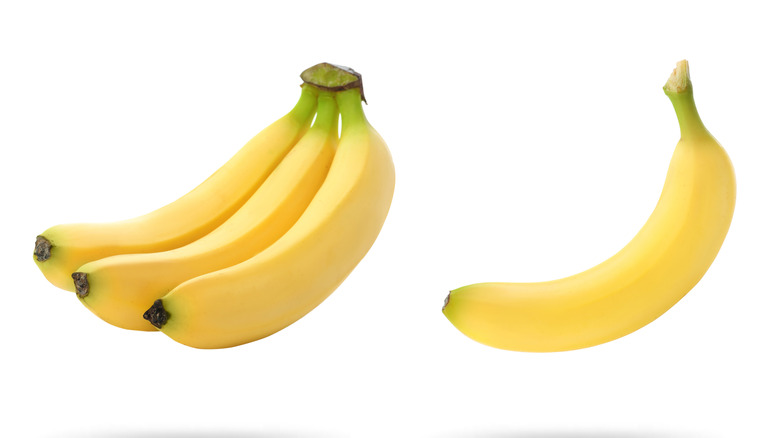The Banana Rule You've Been Breaking This Whole Time
We may receive a commission on purchases made from links.
If you look on your kitchen counter right now, there's a good chance you'll see a bunch of bananas. Bananas have become a staple in most homes in the United States, but there was a time when they were considered a rare tropical fruit. Bananas didn't start appearing on store shelves until the early 1800s when, according to an article from the University of California, Santa Cruz, merchants would buy them from local markets in the Caribbean and ship them to the U.S. However, despite being the third most popular fruit in the United States in 2019, many people don't know the most crucial rule of keeping bananas from spoiling.
According to SFGate, it generally takes a banana around eight days to ripen from the time they are picked, three to four days to ripen if they're purchased green, and approximately one to two days if you buy them when they're yellow. The tricky part is getting those bananas to your preferred ripeness and keeping them there for as long as possible. Let's look at the circumstances that can make your bananas ripen too quickly and what you can do to lengthen their life.
Bananas emit a ripening molecule
According to Scientific American, researchers discovered in 1901 that bananas and other fruits naturally emit a molecule called ethylene gas and that this gas hastened fruit ripening. When many bananas are stored together in a confined space, the produce company Chiquita explains, ethylene gas works its magic to turn a green banana into a ripe yellow one ready for the market. Per Reuters, most commercial banana producers will use ethylene gas and controlled temperatures on unripe fruits to prepare them for the consumer. The reason they are picked at an unripe state, as outlined in a fact sheet from the Postharvest Technology Center, is that bananas allowed to ripen on the tree will often break open, and the texture will be less than ideal.
This same ethylene gas process that makes a banana look appealing at the market can be detrimental to the fruit once you get it home. You know the story. One day they're green, and the next they're ready for the compost pile — this is an example of ethylene gas at work. However, there is a simple way for you to slow down that process and avoid losing your bananas.
Break up that banana bunch
According to Chiquita's website, separating each banana from the bunch is the most effective way of slowing down the ripening process. The large amount of ethylene gas produced by an intact bunch of bananas will ripen them faster. Removing each banana from the bunch will slow down the process and create less waste and sweeter fruit. However, the ripeness of a banana can be subjective — some prefer their bananas to be very ripe, while others enjoy a more firm, less ripe fruit. Separating or not separating the bananas allows you to achieve the level of ripeness you want.
Sometimes the problem isn't too many overripe bananas; it's a bunch of useless green bananas. Don't worry, you can use the power of ethylene gas to your advantage if you want to ripen bananas faster. Merely keep the bunch together and let that ethylene gas do its thing. Chiquita suggests placing bananas in a paper bag with an apple or tomato — both also produce ethylene gas — to speed up the ripening process. Keep in mind: if you store these fruits together when you aren't trying to ripen them, it will still hasten their ripening, so keep them apart if you want your bananas to last.
However, if you're impatiently craving homemade banana bread and lack ripe bananas, according to the experts at MasterClass, the fastest solution is to poke holes in the peel and put it in the microwave. Whatever technique you decide to try, you'll be enjoying that warm slice of banana bread faster than you can say, "pass the butter."


